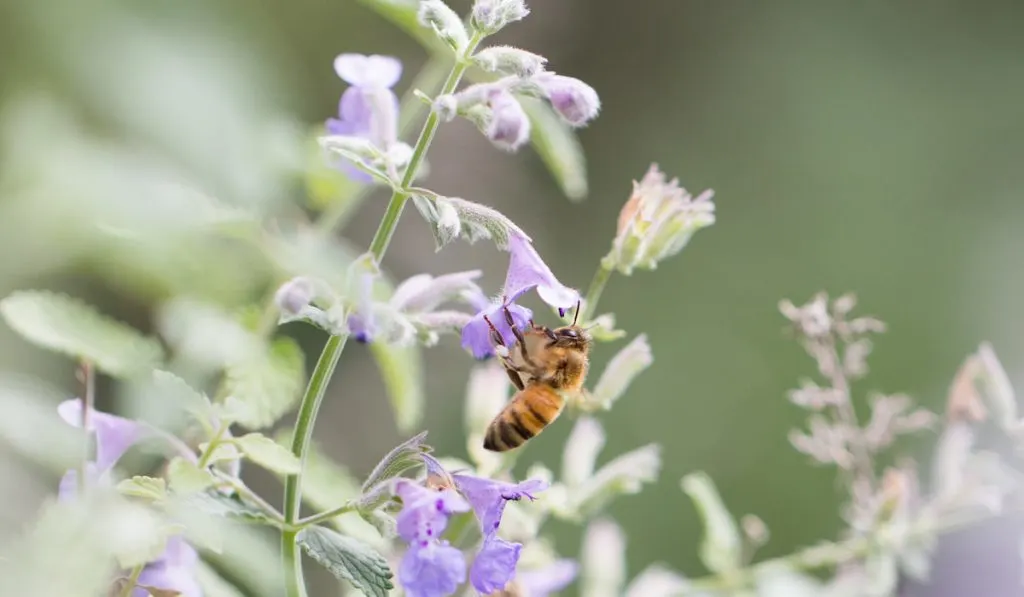*This post may have affiliate links, which means I may receive commissions if you choose to purchase through links I provide (at no extra cost to you). As an Amazon Associate I earn from qualifying purchases. Please read my disclaimer for additional details..
When it rains, it pours, and when it pours, many animals would rather be indoors.
But you may have seen bees flying in the rain, and that may have got you wondering, can they fly in the rain?
Can bees fly in the rain?
Bees can fly in the rain but tend to avoid doing so. Light rain is generally no issue but it is dangerous for a bee to attempt to fly in heavy rain or wind.

While they would rather take cover, bees can fly in the rain. But in most cases, they would only fly when it rains lightly.
Light rain is inconsequential to bees, but the same cannot be said about storms and heavy rains.
When rain gets intense, bees are at risk, so they would rather remain in their hives.
So, what do bees do when it rains? Can they survive getting wet?
Well, the rest of this piece contains more information about the said questions.
Table of Contents
Can Bees Fly in The Rain?
Yes, bees are capable of flight when it rains, but they do not always do so.
When the rain is light, bees can still fly. But when the rain is heavy, it becomes difficult and dangerous for bees to fly.
For one, a bee flying in heavy rain can get knocked down easily. Its wing may also get broken from the impact of the raindrops.
Moreover, a bee flying in heavy rain may get knocked into a puddle and drown. Hence, bees would rather remain in their hives until the storm subsides.

Bees prefer to fly when the sun is out because it makes for easier navigation.
Rightly so since it is harder for them to navigate in cloudy and wet conditions.
Honeybees
When it rains, honeybees will choose to stay in the hive.
Honeybees typically perceive a change in the weather and prepare for it accordingly.
While they forage and store pollen and nectar constantly, the foraging increases a few days before it rains.
This is perhaps one of the ways they prepare for the coming rain.
Carpenter Bees
Carpenter bees are one of the toughest bees. They can withstand some harsh conditions that other bees would rather avoid.
Their size aids them to withstand weather changes that can affect pollination rates.
While strong winds and heavy rain would hinder smaller bees, carpenter bees may be unfazed.
These bees also perform surprisingly well in cold weather.
These traits allow carpenter bees to cover up any slack in pollination when other bees cannot take the risk.
Bumblebees
Bumblebees are most likely to get caught in a rainstorm.
They typically do not stop foraging even when there is a storm.
When it rains heavily, bumblebees are not in any danger and will continue foraging.
But with time, the raindrops will accumulate on their body, making them too heavy to fly.
Can Bees Survive Getting Wet?
Yes, bees can survive if they get wet. When flying in the rain, bees may fall into a puddle. Of course, when they do, they will get wet.
In such cases, for the bees to survive, they try to surf to the edge of the water puddle.
The bees will beat their wings backward and try to drag themselves along the water’s surface.
Then they will pull water up with their wings, creating ripples that slowly push the bees forward to safety.

This process is not efficient for the bees. If they are too far from the solid ground, they will eventually drown.
For bees, swimming is a means of survival until they get to safety, and it consumes a lot of their energy.
If you happen to find a bee stuck in a puddle on a rainy day, you could help it by getting it out and placing it somewhere safe and dry.
You may place the bee on a terrace, under a leaf, or anywhere safe at all.
Wherever you place the bee, ensure it is not far off from where you found it.
If you believe the conditions are not safe for you, you should leave the bee alone.
What Do Bees Do When It Rains?
When it rains heavily, bees usually remain in their hives.
However, when it showers lightly, they may go out to forage.
Rain can be a hindrance when the bees are harvesting nectar. In a case when rain gets in nectar, it would dilute the nectar.

When diluted, nectar loses its usefulness to bees.
Consequently, the bees will have to wait another time to go harvesting.
Under misty conditions, if a bee’s body gets covered in mist, flying may become difficult.
All covered in vapor, bees find it harder to flap their wings at the usual rate of 12,000 beats per minute.
Heavy raindrops can knock down a bee in flight, leaving them in possibly fatal situations. Bees in such conditions may drown or lose their wings.
For this reason, when it rains heavily, bees outside the hive seek shelter until it stops raining. When the weather is clear, they fly back to the hive.
Of course, when it rains heavily, those in the hive remain there until it stops raining.
Bees perform several activities during a rainstorm. For one, they fill crevices and creases in their hive with propolis.
This activity is particularly vital for the durability of a new hive.
New hives are typically not as strong as old ones since the bees have not reinforced them well enough.
The activity at the hive entrance lessens because the forager bees will choose to remain inside.
At the same time, forger bees outside the hive will begin to make their way back.

With so many bees in the hive, demand for food will increase, and the workload will also increase.
The available forager bees will be reassigned to manage the temperature and humidity of the hive.
Conclusion
Bees can fly in the rain. However, they often choose not to, especially when it rains heavily.
They prefer foraging when the sun is out and not too hot. During such times, it is easier for them to navigate and there are fewer dangers.
Resources
- https://www.azcentral.com/story/claythompson/2014/11/21/bees-rain-cinnamon-scorpions-insects-pests/19369577/
- https://backyardbeekeeping.iamcountryside.com/health-pests/bee-weather-series-how-to-help-bees-during-spring-rain-and-storms/
- https://www.discovermagazine.com/planet-earth/when-a-bee-falls-in-water-it-surfs-tiny-ripples-to-safety
- https://pestlockdown.com/can-bees-fly-in-the-rain/
- https://sprigglys.com/2018/02/22/carpenter-bees/
- https://schoolofbees.com/can-bees-fly-in-the-rain/
